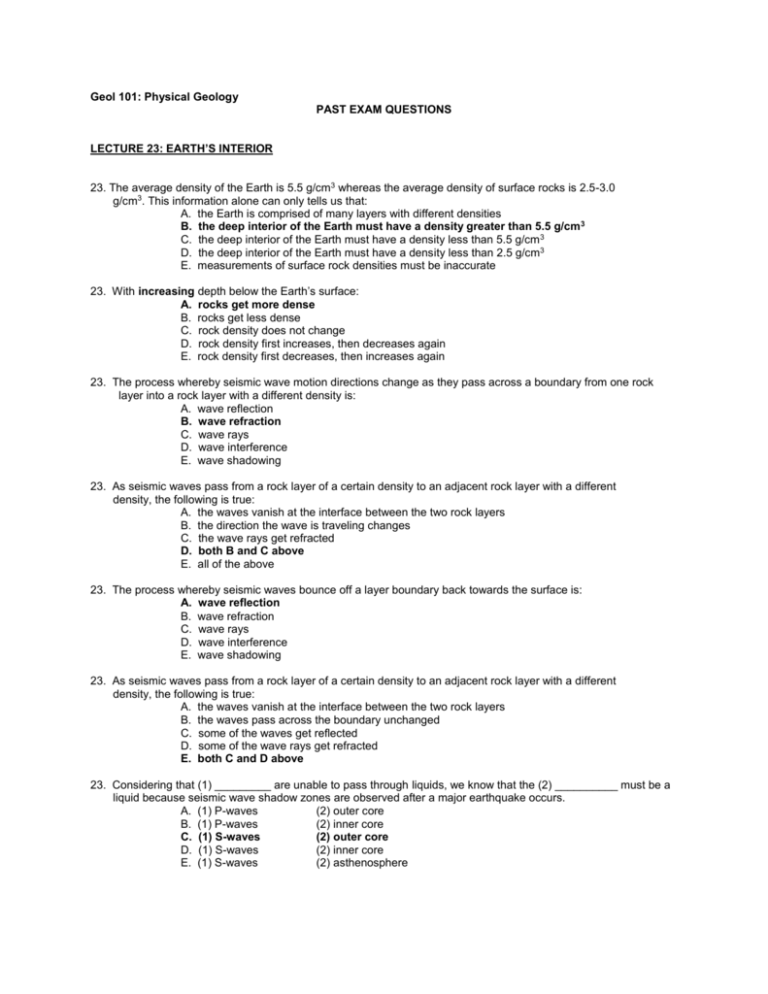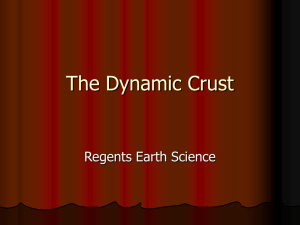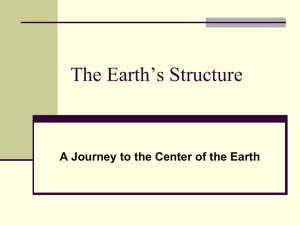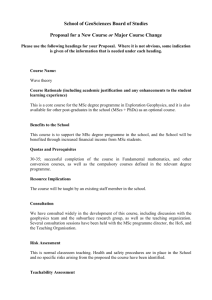Word
advertisement

Geol 101: Physical Geology PAST EXAM QUESTIONS LECTURE 23: EARTH’S INTERIOR 23. The average density of the Earth is 5.5 g/cm3 whereas the average density of surface rocks is 2.5-3.0 g/cm3. This information alone can only tells us that: A. the Earth is comprised of many layers with different densities B. the deep interior of the Earth must have a density greater than 5.5 g/cm 3 C. the deep interior of the Earth must have a density less than 5.5 g/cm 3 D. the deep interior of the Earth must have a density less than 2.5 g/cm3 E. measurements of surface rock densities must be inaccurate 23. With increasing depth below the Earth’s surface: A. rocks get more dense B. rocks get less dense C. rock density does not change D. rock density first increases, then decreases again E. rock density first decreases, then increases again 23. The process whereby seismic wave motion directions change as they pass across a boundary from one rock layer into a rock layer with a different density is: A. wave reflection B. wave refraction C. wave rays D. wave interference E. wave shadowing 23. As seismic waves pass from a rock layer of a certain density to an adjacent rock layer with a different density, the following is true: A. the waves vanish at the interface between the two rock layers B. the direction the wave is traveling changes C. the wave rays get refracted D. both B and C above E. all of the above 23. The process whereby seismic waves bounce off a layer boundary back towards the surface is: A. wave reflection B. wave refraction C. wave rays D. wave interference E. wave shadowing 23. As seismic waves pass from a rock layer of a certain density to an adjacent rock layer with a different density, the following is true: A. the waves vanish at the interface between the two rock layers B. the waves pass across the boundary unchanged C. some of the waves get reflected D. some of the wave rays get refracted E. both C and D above 23. Considering that (1) _________ are unable to pass through liquids, we know that the (2) __________ must be a liquid because seismic wave shadow zones are observed after a major earthquake occurs. A. (1) P-waves (2) outer core B. (1) P-waves (2) inner core C. (1) S-waves (2) outer core D. (1) S-waves (2) inner core E. (1) S-waves (2) asthenosphere 23. As a result of seismic waves interacting with the liquid layer mentioned in the previous question, within what region do seismographs show no record of the earthquake ever having occurred? A. the S-wave shadow zone B. the P-wave shadow zone C. the epicenter D. the opposite side of the earth to the earthquake E. no such region exists 23. In the P-wave shadow zone: A. most seismic waves from earthquakes never get recorded by seismometers B. S-waves predominate C. earthquakes are impossible D. the days are darker than usual E. geophysicists turn off their seismometers and go to bed early 23. When seismic waves from an earthquake reach the boundary between the mantle and the liquid outer core: A. all of the body waves get refracted B. all of the body waves get reflected, but none are refracted C. all P-waves stop because they are unable to move through the outer core D. all S-waves vanish because they cannot move through a liquid E. all P-waves speed up as they pass into the outer core 23. We know that the outer core is a liquid because: A. an S-wave shadow zone is produced by the S-waves being stopped dead B. a P-wave shadow zone is formed C. S-waves get refracted through the outer core D. P-waves get reflected off of the inner core boundary E. S-waves pass into the outer core but cannot get out again 23. Because the outer core is liquid: A. the inner core is liquid B. S-wave velocities decrease suddenly at the edge of the outer core C. P-waves are unable to pass through the outer core D. an S-wave shadow zone exists at greater than 105° away from an earthquake focus E. a P-wave shadow zone exists at greater than 140° away from an earthquake focus 23. The Mohorovicic discontinuity, better known as the Moho, is: A. the boundary between the crust and the mantle B. the boundary between the lithosphere and the asthenosphere C. the boundary between the mantle and the outer core D. the boundary between the outer core and the inner core E. a region in Yugoslavia where seismic waves mysteriously vanish 23. The boundary between the crust and the mantle is called the: A. Mojo B. Jomo C. Ohno D. Moho E. SloMo 23. The average thickness of continental crust is about: A. 1 km B. 5-10 km C. 8 km D. 35 km E. 100 km 23. The reason the Earth is able to have plate tectonics is because: A. the asthenosphere is soft and gooey so the plates can move around on top of it B. the lithosphere is brittle so it has been able to break apart to form the plates C. convection in the mantle provides a driving force to move the plates around D. subduction of old crust makes room for new crust forming at mid-ocean ridges E. all of the above 23. Continental crust, which commonly forms high mountains, is thicker, and stands higher, than oceanic crust: A. because continental crust is denser than oceanic crust B. because continental crust is less dense than oceanic crust C. because of the principle of isostacy D. both A and C above E. both B and C above 23. The rocks of oceanic crust are typically made up of: A. basalt only B. gabbro only C. basalt and gabbro D. peridotite only E. basalt and peridotite 23. The Earth has a magnetic field because: A. the liquid outer core creates an electric current which induces a magnetic field B. magnetic minerals are common at temperatures above the Curie point C. it has a magnetic iron-nickel core D. all planets have magnetic fields when they form E. the Earth is a giant domino








